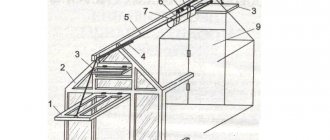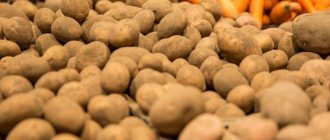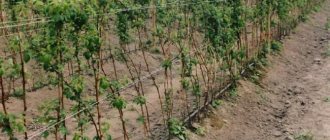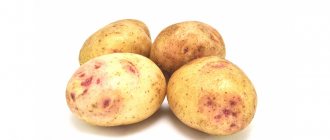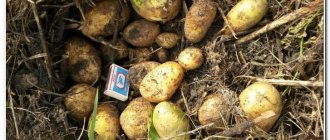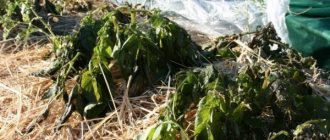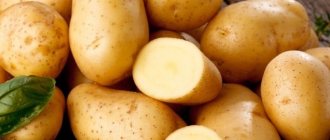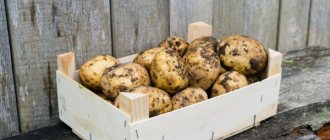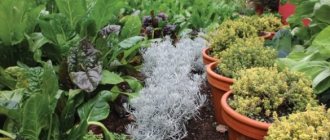Both storing potatoes in a cellar and storing potatoes in a basement involves protecting the crop from freezing. The question of at what temperature do potatoes freeze has been discussed more than once on various Internet forums, and many articles have been written about this. Any temperature below zero, or even zero, is considered negative.
At minus 1, partial freezing occurs, and at 3–4 degrees below zero, the potatoes freeze. Even if you store potatoes in the cellar, there is a possibility that frost will reach there. If the cellar or basement is not insulated, and the harvest has not yet been dug up, it’s time to take care of insulation.
At the same time, if the storage facility is located outside the house, then you can build additional protection from frost, snowfall and winds - a canopy or roof. The descent hatch is also insulated with foam plastic or other insulating material.
But when creating the best storage conditions, you should not be too zealous. Otherwise, the temperature of the initial freezing of potatoes will smoothly develop into the temperature of its germination. And sprouts begin to appear already at 4 degrees.
When storing potatoes on an unheated balcony or in a garage, there is often a danger of vegetables freezing. The condition of the tubers depends on the air temperature in the storage:
- at temperatures from 2 to 5 °C, potatoes retain their taste; at higher temperatures, they germinate prematurely and begin to wither;
- from 0 to 1 °C, short-term decreases to -1 °C, starch begins to break down, and over time a sweet taste appears;
- potatoes freeze at a temperature of -1.7 °C and below, acquiring a pronounced sweet taste. As the temperature rises, frozen tubers begin to rot; those intended for planting lose their viability.
Preparing potatoes for winter storage at home
There are five main stages in the process of preparing potatoes for storage. Below we will analyze each of them.
Cleansing from the earth
Washing tubers with water is strictly prohibited , as excess moisture will subsequently lead to rotting. It is enough to clean off the dried earthen lumps by hand.
Drying
For this stage, choose a shaded, ventilated room with dry air. Potatoes peeled from soil are laid out in one layer to dry completely. It is important to ensure that the vegetable is not exposed to sunlight.
Sorting
At this stage, illiquid product damaged by pests or during the harvesting process is eliminated. Diseased specimens are removed from the bulk - such potatoes will spread the infection among the stocks.
It is recommended to sort potatoes by size for ease of storage. If you sort through your own grown potatoes, some are set aside for planting next season.
Period of synthesis of antimicrobial substances
Within a month after harvest, the process of formation of suberin and cells occurs in the tubers, preventing pathogenic bacteria from entering the vegetable. For high-quality prevention, a temperature regime of +12...+18°C is required, so potatoes are not harvested immediately into the cold.
After sorting, 3-4 weeks are given to complete the biochemical processes.
Collection and packaging
Potatoes are placed in bags, boxes or other containers for long-term storage.
Why is it worth stocking up on potatoes for the winter?
In the basement, potatoes can be kept in wooden boxes or in bulk. But at the same time, the distance to the ceiling should not be less than half a meter. Again, you need to observe the temperature regime - when the temperature drops, turn on the heater.
The article describes the technology of growing tomatoes in open ground.
If the humidity in the basement is higher than normal, we recommend sprinkling the potatoes with sawdust or peat. You can also sprinkle beets on top - this vegetable absorbs moisture very well. In this case, you will have to sort through your supplies more often and be sure to remove rotten root crops.
Ideally, it is best to place potatoes in boxes in the basement. This should include approximately 30 kilograms of potatoes. It is good if the boxes are made of coniferous wood - this prevents the growth of mold and bacteria. We recommend placing the boxes in the form of a pyramid. If you stack the boxes on top of each other, this will not provide good ventilation. If the basement is cold in winter, you should follow our recommendations when constructing boxes:
- Ideally, the box should have double walls
- There should be 10-15 centimeters between the walls of the box, where you need to put polystyrene foam for insulation.
- the box should be made of thick plywood, after manufacturing it should be painted white
- You need to install one light bulb in the box - it is painted dark so as not to cast light on the tubers
What early tomatoes look like for a greenhouse is indicated in the article.
Storing potatoes on the balcony of a high-rise building is not at all a way to simply save money, since in winter any vegetables, including potatoes, are more expensive than during the period of their mass harvest. Rather, it is a way to save time and nerves.
Accordion of potatoes with lard or bacon.
If the store that sells fresh vegetables is far away or is not open 24 hours a day, then you will have to postpone your desires until tomorrow.
Therefore, the majority of our citizens prefer to stock up on potatoes, cabbage, carrots, and beets. Stocks are made, if not for the entire winter period, then at least for every month, so that the lack of necessary vegetables in the house does not take the housewife by surprise.
After a fairly short time, they will wither and begin to sprout. Therefore, the best place to save them in an apartment is the balcony. But for this, appropriate conditions must be created in this space.
Potato response to temperature
If the temperature regime is violated, the crop begins to deteriorate. As the temperature rises, the potatoes sprout and become soft. When there is a decrease in fruits, the process of processing starch into sugar starts. The product loses its original taste properties, becomes excessively sweet and lethargic.
Important! Only high-quality potatoes can be stored for a long time. When selecting vegetables for the winter, pay attention to their external condition. Potatoes with thick skins can withstand temperature fluctuations more easily.
The minimum temperature that potatoes can withstand is 0°C. Minus values have a detrimental effect on the vegetable. If the thermometer drops below -1°C, then supplies begin to freeze. It is no longer recommended to eat such potatoes.
At what degrees do potatoes freeze on the balcony? Freezing of potatoes during storage
Both storing potatoes in a cellar and storing potatoes in a basement involves protecting the crop from freezing.
The question of at what temperature do potatoes freeze has been discussed more than once on various Internet forums, and many articles have been written about this. Any temperature below zero, or even zero, is considered negative. At minus 1, partial freezing occurs, and at 3–4 degrees below zero, the potatoes freeze. Even if you store potatoes in the cellar, there is a possibility that frost will reach there. If the cellar or basement is not insulated, and the harvest has not yet been dug up, it’s time to take care of insulation.
At the same time, if the storage facility is located outside the house, then you can build additional protection from frost, snowfall and winds - a canopy or roof. The descent hatch is also insulated with foam plastic or other insulating material.
But when creating the best storage conditions, you should not be too zealous. Otherwise, the temperature of the initial freezing of potatoes will smoothly develop into the temperature of its germination. And sprouts begin to appear already at 4 degrees.
When storing potatoes on an unheated balcony or in a garage, there is often a danger of vegetables freezing. The condition of the tubers depends on the air temperature in the storage:
- at temperatures from 2 to 5 °C, potatoes retain their taste; at higher temperatures, they germinate prematurely and begin to wither;
- from 0 to 1 °C, short-term decreases to -1 °C, starch begins to break down, and over time a sweet taste appears;
- potatoes freeze at a temperature of -1.7 °C and below, acquiring a pronounced sweet taste. As the temperature rises, frozen tubers begin to rot; those intended for planting lose their viability.
Prerequisites for quality storage
Being able to grow excellent potatoes is a serious matter that requires a lot of time and effort. But that's only half the battle. It is important to know how to store potatoes without loss, so that there is enough for planting in the spring and for consumption until the new harvest.
Proper cleaning
Successful storage depends on many factors. The conditions in which potatoes grew, as well as timely harvesting, affect the ability of the vegetable to retain its qualities longer.
When the tubers stop growing, the vegetative part of the bush dries and dies. The time has come to stockpile them for the winter.
During the growing season, it was necessary for growth and maturation. But as soon as it dries out, the shoots and leaves become a habitat for fungal infections that can migrate to the fruits.
Potato harvest time
There is no need to mow the stems ahead of time. Harvesting begins a couple of weeks after the tops are cut. Before sampling from the ground, the degree of maturity of the potatoes is determined. If the skin is scraped off, it means that the tubers are not yet ripe, they will begin to wither and will not be stored well.
Turnips - what is it, composition and types of plants, care and cultivation, cooking recipes
Summer plantings are harvested before frost begins. To prevent the potatoes from getting sick, you should not delay digging them up. Otherwise, it leads to weight loss and makes it a target for pests and diseases. Potatoes harvested on a sunny day will remain dry, which will have a positive effect on their keeping quality and storage.
In order to harvest seed material, the tubers are harvested 15-20 days after the plant has flowered. At this stage, it is easy to identify powerful, healthy bushes with large tubers that are ideal for planting a new crop. The tops are mowed without waiting for them to die.
The dug up potatoes are dried for a couple of hours; if it is cloudy, the time is extended to 3-4 hours. Planting of potatoes selected for seeds is carried out, excluding exposure to direct sunlight, which can burn the potatoes.
Preparing storage facilities
While summer residents and gardeners are harvesting, they are simultaneously carrying out activities to prepare storage space. The question of how to properly prepare vegetable storage facilities and preserve potatoes without loss becomes relevant.
Cellars and basements are prepared in advance. During the preparation process you should:
- check the operation of the ventilation system;
- inspect mechanical devices (if any);
- install a thermometer to monitor the temperature;
- disinfect areas for storing vegetables.
As a rule, to preserve the product at home, it is placed in cellars and basements. Before loading the crop, they are cleaned, dried and disinfected. For disinfection, you need to prepare a solution using 1 bucket of water, lime (2.5 kg) and copper sulfate (100 g). For storage, tubers are placed in boxes, containers or bins. It is good to store them in grids as well. But there are other options.
Storage
Storing potatoes in pits and trenches
Potatoes are stored well in a hole 1.5 m deep and 2 m wide. The tubers are laid in a layer about 1 m thick. Sprinkle 5-10 cm of sand on top, then cover with soil. With the arrival of cold weather, such storage is insulated. By covering it with peat, leaves or straw, the owner can count on complete safety of the contents. The vegetable is placed in trenches 1 m wide at the end of autumn, not filling up to the soil level by 10-15 cm. Then the top is covered with straw, pine needles and earth (0.5 m).
How to store in an apartment
In the absence of other space, you can store what you have collected using a cooler place. This could be the space under the sink or sink in the kitchen. Place the potatoes in a basket, basin or bucket with holes made for ventilation. Many people keep it on a glazed loggia and on an insulated balcony.
The refrigerator can also be used as a vegetable storage facility, but the disadvantages of this method include the lack of sufficient space in it. You can also make a wooden box (box), insulated from the inside with polystyrene foam, and place a starchy vegetable in it. It’s good to hide such a “container” in a storage room (vestibule) on the site.
Those who don’t want to bother with a wooden box can purchase a ready-made industrial chest for storing potatoes, which is produced in Moscow. Made of painted metal, it weighs about 40 kg and has dimensions of 1050x630x850 mm.
Potato
What temperature can potatoes withstand in the ground?
I planted potatoes as seedlings, now I’m thinking - when should I plant them at the dacha? You can protect from frost, and covering such a quantity is not a problem. I know about planting potatoes - when the birch tree is covered with a “green haze”. What other signs? I found a hint on the temperature on the Internet. The requirements of the potato plant to environmental conditions at different periods of life are not the same. In addition, different plant organs exhibit different reactions to the same factor. For example, a temperature of 12 degrees significantly inhibits plant growth, but it has a beneficial effect on tuber formation. Potato plants develop better in cool summer conditions. The buds of the eyes awaken at 3-6 degrees. Tubers begin to germinate intensively at soil temperatures of 7-12 degrees, but this process occurs faster at 20 degrees. Potato roots form at temperatures not lower than 7 degrees, so you can start planting them only when the soil at a depth of 10-14 centimeters warms up to 7-8 degrees. For mass emergence of seedlings, the optimal air temperature is within 15-25 degrees. At very low and very high temperatures, germination rates slow down. At a temperature of 3-5 degrees, in some potato varieties, growth is so weakened that the buds on the tubers begin to develop without the formation of a root system. At temperatures below 3-5 and above 31-35 degrees, their growth and development are suspended, and the presence of potato tubers for several days at a soil temperature of 1-1.5 degrees or 35-40 degrees usually leads to severe damage to the buds and tubers, from which it is already difficult to obtain normal, well-developing plants. Potato seedlings require cool, moist weather to develop. At this time, tender young plants are equally sensitive to both cold and heat and dry winds. Potato tops begin to grow at an air temperature of about 5-6 degrees, and their maximum growth occurs in moderately moist soil and 17-22 degrees. At temperatures above 42-45 degrees, tops growth stops, and at 50 degrees the plant withers and may die. The tops are also sensitive to low temperatures. When there is frost minus 1 - 1.5 degrees, the plants turn black and die. Therefore, when growing early potatoes, the choice of site is of great importance. Thus, in low areas, where cold air stagnates in the morning, seedlings are more often damaged by frost than in higher areas. The most favorable temperature for potato flowering is 18-21 degrees. Hotter weather causes the flowers and buds to drop. Typically, at a temperature of 27-29 degrees, flowering stops. The flowers themselves have no economic significance. The presence or absence of flowers on potato plants does not affect its yield. Therefore, there is no point in carrying out a lot of manual work to remove flowers, which is practiced by some potato growers. (This was confirmed by the experiments of Oleg Telepov, a famous potato grower). For most potato varieties, the most favorable soil temperature for tuberization is 15-19 degrees, which corresponds to an air temperature of 21-25 degrees . At soil temperatures below 6 and above 23 degrees, tuber growth decreases sharply, and at 26-29 degrees it stops. High temperatures combined with long daylight hours cause the transformation of stolons into above-ground shoots and the growth of tubers. On the other hand, heat and drought promote the formation of a large number of stolons and their branching, resulting in an increase in the number of small tubers. If during the period of formation and growth of tubers there is prolonged hot weather (30-40°C), this causes “ecological” degeneration of the potato. It consists of metabolic disorders and a sharp decrease in the yield and seed qualities of tubers. During hot and dry periods, the growth of young tubers stops; apical eyes sprout on them, which form sprouts and secondary tubers at soil temperatures above 20-30 degrees. At temperatures above 29 degrees, such sprouts develop into above-ground stems, and then form their own root system and above-ground mass. This overgrowth of tubers significantly reduces the yield and its quality.
How does the shelf life of vegetables depend on temperature?
Potatoes are a demanding vegetable when it comes to storage conditions . Failure to comply with the recommended temperature conditions will lead to spoilage of supplies. The suitable storage temperature for potatoes is +2°C, a deviation of 1-2°C is allowed. Air humidity is quite high, not lower than 60%.
If the place where potatoes are stored is too warm, the tubers will begin to sprout. Also, high temperatures can cause the vegetable to begin to release excessive moisture and wither.
At zero air temperature, the starch in potatoes will turn into sugar and give the root vegetables a sweet taste.
At sub-zero temperatures, potatoes freeze and become unfit for consumption.
Potato storage conditions
To prevent potatoes from freezing or rotting, you need to know under what conditions this vegetable is stored. Let's focus on the main points.
- Temperature conditions. First of all, you need to know at what degrees potatoes freeze. Any sub-zero temperature is unacceptable for him. The optimal storage temperature is 4°C. Deviations of 1-2°C are allowed, but no more. If the temperature drops below 2°C, the vegetable will freeze, which will affect not only the taste, but also the shelf life. The vegetable will begin to spoil faster. If the temperature rises above 6°C, the potatoes will begin to dry out. This will negatively affect its taste, and its appearance will become unattractive.
- Humidity level. This indicator is no less important than air temperature. For storing potatoes, the optimal air humidity is 40%. As with the temperature regime, slight fluctuations in both directions are allowed here.
- Air exchange. It is important to create storage conditions under which air will flow to the tubers. The room should be ventilated from time to time. Without air circulation, vegetables quickly rot.
- Light. Any light is undesirable. When exposed to sunlight or light from an artificial source, the sides of the potatoes turn green. In this case, a certain substance is produced that makes the product harmful. You can't eat these potatoes. If electric light bulbs are used to heat the balcony, they should be covered with any material through which light does not penetrate. As an option, you can cover the potatoes with a dark cloth while heating.
a brief description of
The culture is classified as annual. Sometimes it takes two years to grow it: during the first year, seeds are sown in a garden bed and small nodules are collected, in the second year small potatoes are planted, and full-fledged large tubers are collected.
The bush of the plant has fibrous roots, succulent stems and foliage of various shades of green. The seeds, located in the round green fruits, are formed after flowering and maintain the purity of the variety. But this method of propagation is more labor-intensive and not so popular among gardeners. Most potato lovers are convinced that it is better to plant them with tubers or parts thereof.
Potato
Additional heating
Storing potatoes on an unheated balcony in winter is more difficult than in an apartment. You won’t be able to get by with a DIY vegetable cabinet. In severe frosts, the crop freezes in it. It is best to insulate a balcony or loggia or build a heated container.
We suggest you read: How to grow Chinese pak choi cabbage
To build such a container you will need 2 boxes of different sizes. A stand for the smaller box is installed at the bottom of the larger box. The easiest way is to put wooden blocks of the required size. The boxes are stacked on top of each other so that there are equal gaps between all the walls.
Insulation is placed in the gaps between the walls of the boxes. Sawdust, polystyrene foam, corrugated cardboard or rags are used as insulation. Any heating element is installed in the gap formed between the bottom of the larger and smaller box, after which a lid is constructed.
An ordinary incandescent lamp can be used as a heating element. It is installed between the side walls of the boxes. Insulation is placed in the space between the bottom of the larger and smaller boxes. You can also use a heating cable, as in the “warm floor” design. If desired, a homemade box is equipped with a thermostat.
A similar design can be made from an old refrigerator. In this case, the task is simplified, since thermal insulation is already laid between the walls of the refrigerator. A thermostat is installed in the lower section, which is usually intended for storing vegetables. The structure is ready.
Another option is the balcony cellar offered on the market. It protects the crop even at temperatures of -40°C. Such a balcony cellar is expensive, and it requires connection to the electrical network, so you will have to take into account additional electricity costs.
What you need to know about the influence of tuber varietal on the choice of storage temperature
The dormant period of the plant organism is directly related to the duration of the growing season. In relation to potatoes, the dependence is manifested in the difference in shelf life of tubers belonging to varieties of different ripening periods.
Early and mid-early potato varieties are not intended for long-term winter storage. These are “Aurora”, “hostess”, “Rocco”, “Peter’s mystery” and others. Dug up young potatoes with delicate skin quickly lose their presentation and deteriorate.
After ripening (criterion - the peel has become strong), tubers of early varieties can last 4-5 months at a temperature of +2...+4 °C. Typically, summer residents plant early varieties in small quantities - enough for daily consumption of young tubers and storing seed for storage.
“Atlant”, “Yavir”, “Zhuravinka”, “Zdabytak” and other varieties of mid-late and late ripening are ideally suited for storing for long-term winter storage. Long-term - until May-June inclusive.
The above does not mean that late varieties of potatoes do not require special storage conditions.
Tubers of late-ripening varieties have a longer dormant period and are adapted to long-term storage in optimal conditions of +2…+4 °C. At the end of spring, such a temperature in the potato storage can only be maintained with the help of special equipment, which is actually feasible in practice when harvesting potatoes only on an industrial scale.
At the end of spring, closer to the end of the shelf life, maintaining the temperature-humidity balance becomes especially important.
How to protect vegetables from freezing
The first thing you should pay attention to when storing root crops for long-term storage is their moisture and cleanliness.
As long as it is not too cold outside, clean and dry potatoes on the balcony will not freeze and begin to rot. Especially if you store it in boxes made of thick corrugated cardboard. Since potatoes contain a large amount of water, they can withstand temperatures not lower than zero.
This means that it is even theoretically impossible to preserve potatoes on an open balcony without glazing in winter - they will simply freeze. But with a slight decrease in temperature (down to -10° C), only that layer of root crops that will be in direct contact with cold air or the floor will suffer frostbite. Inside, in the very center of the bag or box, the potatoes will not freeze.
True, if you fry frozen potatoes (that have not had time to thaw and turn black), they will have a rather unique sweetish taste. Some people even like it. The acquisition of a sweet taste by potatoes is due to the fact that one carbohydrate (starch) turns into another (sugar) when the temperature decreases.
And yet, how to store potatoes so that they do not freeze even in severe frost?
This temperature cannot be achieved on an open balcony. But if this is an unglazed loggia (when the sides are closed and there is a concrete panel on the facade), then it is quite possible to create normal conditions for root vegetables.
It is better to store different varieties of potatoes separately.
It is important to seal the corner joints of this box. If its walls are sufficiently thick (about 5 cm), it closes tightly, then such storage will serve as a thermos. The temperature inside will be maintained at the same temperature as the product in this container.
Also on the open loggia you can make a box for storing root vegetables in the winter from plywood or boards. But it also needs to be insulated. The optimal material for insulation, in addition to sheet foam between two layers of plywood or boards, can be corrugated cardboard in several layers.
In addition, if you make an insulated box on some elevated base, then you can store root vegetables in it for several cold months.
You can also cover the potato storage box with old blankets or coats.
The simplest box insulated with foam plastic.
Some home craftsmen suggest making a winter storage for potatoes on the open balcony with heating, sensors and automatic heating shutdown relays. But such a structure, during its manufacture and operation, will probably cost more than the monthly purchase of potatoes in a supermarket or market.
The box is a thermos with foil insulation.
In this case, screened insulation of the same type is used as for the under-roof space of houses. If such insulation has a microporous surface to remove moisture, then storing potatoes on a balcony, even one that is not insulated at all, will be very effective.
They can be hung on powerful dowels to the wall of the balcony. They are designed for a volume of 1 to 3 bags of potatoes. The manufacturer claims that such balcony cellars are capable of storing root vegetables at temperatures down to -40° C. Balcony cellars operate on electricity. Electricity consumption ranges from 120 to 240 W.
Such storage can be placed or hung.
The decision whether to purchase ready-made balcony storage rooms or make the storage facility yourself is always up to the owner.
Storage on the balcony
The balcony is a good place to store vegetables for residents of apartment buildings. Leaving the harvest on it or a loggia is practical and convenient, but you must follow certain recommendations so that the products are preserved and do not waste their qualities.
How to equip a balcony for storage
The balcony or loggia should preferably be glazed. The crop should be placed so that it is not exposed to water or sunlight. As long as it’s warm outside, you don’t have to worry about the safety of the potatoes, but the first autumn frosts can harm them.
The most important thing is the choice of containers for placing the potatoes. Often an old refrigerator or an insulated box is used for these purposes. The best option would be a thermal cabinet that provides ideal storage temperatures and continuous ventilation. But such a cabinet will require electrical power.
Important! If vegetables are stored in a tightly closed space, rotting processes may begin in them. Proper storage requires constant ventilation and air humidity.
At what temperature do potatoes freeze when stored on the balcony?
If the balcony is insulated, then additional protection for the crop will not be required. In a room with double-glazed windows and thermal insulation, potatoes can be stored even in harsh winters.
Blekhnum fern or derbyanka Care at home Photos and descriptions of varieties
You just need to make sure that the room does not cool to -1°C or lower - for this you will need a thermometer on the balcony. At stable temperatures above 0°C, the crop can be placed in bags, nets or ordinary wooden boxes.
Storage nuances:
- As spring temperatures warm, potatoes may require additional cooling or a cooler location.
- The temperature on the balcony should not exceed +17°C, otherwise the vegetable will spoil.
- In the spring, at the end of the storage period, temperature changes are especially harmful to the crop; you should try to avoid them.
- At the end of spring, only late varieties usually retain good taste. The remaining specimens can be used as planting material.
At what sub-zero temperature can potatoes be stored? Plastic boxes
We assemble compact and lightweight collapsible plastic boxes using grooves into which we insert the side walls onto special rails. In the spring we will dismantle this structure.
Boxes made of dense polyethylene are very popular for storing potatoes on the balcony
Often potatoes on balconies are stored in chests made of carefully fitted boards, lined inside with extruded foam more than 2 cm thick: 1 cm of foam per 10 cm of concrete wall.
We insulate the bottom and lid in the same way as the walls - according to the principle of a thermos. Potatoes can be stored in bulk and checked once a week for their integrity and mixed at the same time.
Please note: a wooden cellar on the balcony will be constantly exposed to temperature changes. To protect the box from rotting, use a special impregnation.
For those who want to know how to store potatoes on the balcony in winter - useful
As you can see, putting together a mini-pantry from boards is not at all difficult, just like buying a ready-made cellar in a store, but under one condition - if it is possible to install a vegetable storage on a glazed balcony. A large wooden box can also be useful in the summer - for folding winter clothes and shoes, which take up a lot of space in closets.
The cellar is a very good place to store root vegetables, as it is cool and dark. But you need to monitor the temperature: if it gets a little cold in the cellar, the potatoes need to be covered with straw or warm clothing, for example, a quilted jacket.
How to grow potatoes from seeds is described here in the article.
You need to think about ventilating the cellar and having good ventilation in this place. Otherwise, the potatoes will begin to rot. Before placing potatoes in the cellar, you need to dry the cellar and clear it of debris. And the walls need to be treated against fungus and parasites. It is advisable to whitewash the boxes with lime. You can also buy special preparations in stores that will absorb water from the environment.
How to properly equip a cellar in a country house? Usually the main problem in our climate is to protect the cellar from freezing. Therefore, listen to our advice.
- You can make a cellar above the cellar - this is a booth that will protect the cellar from the environment in very severe frosts.
- The cellar should be closed so as not to allow air to pass through - it can be insulated on top with polystyrene foam.
- The ceilings in the cellar can also be insulated with some kind of thermal insulation material.
- In different corners of the cellar you can hang light bulbs that are painted in a dark color - they can be turned on in very severe frosts for additional heating of the cellar.
Naturally, simply scattering potatoes on the floor of the balcony or putting them in a corner in a fabric bag is a bad idea. In order for this vegetable to be stored for as long as possible and retain its rich taste and beneficial properties, you will have to take care of the equipment of the boxes to place it.
You can do this in several ways:
- Make a box out of wood (boards, clapboards, slats, etc.). In this case, the presence of gaps between the boards will act as ventilation, but this is only suitable for carefully insulated and waterproofed balconies;
- Make a box out of wood without gaps and insulate it. Any foam insulation and a layer of cardboard on top of it, glued from the inside of the box, will create conditions quite comfortable for root vegetables;
Thermal box made by a professional
- Process and insulate ready-made wooden or plastic vegetable boxes, which are easy to find in markets or large chain stores - they are often thrown away, so they will definitely give you a couple of boxes;
- Buy plastic boxes or a chest of drawers for storing things and toys, and then lay soft warm fabric or insulation inside it;
- Use an old refrigerator, chest of drawers, drawer table or chair with storage space under the seat for storage;
Box from an old refrigerator
- Create boxes with an automatic heating and temperature control system. This option is only possible if you have the necessary skills and funds, since the costs of such equipment can significantly exceed the cost of the potatoes themselves over several seasons;
- Purchase special backpack-type bags designed for storing vegetables on the balcony and hang them on the insulated walls of the room.
Storage rules
To preserve potatoes, it is necessary to ensure optimal conditions, consisting of:
- Maintaining optimal humidity in the room where potatoes are stored. It shouldn't be raw. You can use a hygrometer or simply carefully inspect the walls and ceiling. If mold or other fungal colonies, slugs or woodlice are found, the room is waterlogged, and the potatoes will be susceptible to disease. And, conversely, if the tubers are too dry, they will lose moisture, wither and wrinkle.
- Eliminating drafts that can lead to temperature changes. In frosty weather, there is a risk of potatoes freezing precisely in the presence of a through air flow.
- In blocking access of light to the potato storage.
Temperature
The question arises what temperature the potatoes can withstand. It would be good if it was 0°C in storage areas. The tubers can withstand it, but there is a risk of missing the moment when it drops and provokes freezing. A decrease in temperature even for a short time leads to undesirable consequences.
To prevent it and avoid hypothermia, it is better to maintain the air heated to +2° or +3°C.
Depending on the period, the temperature during storage of potatoes varies.
During the post-harvest or treatment phase (lasting from 1.5 to 3 weeks), tubers should be stored at t = 15-20°C. Air humidity ranges from 85 to 95%. At the end it is lowered to 8-10 °C. Then for 3-7 weeks it is maintained at a level of 2°C to 5°C. In such conditions, potatoes continue to be stored throughout the winter.
The different intended purposes of the vegetable dictate the difference in the heat-cold mode, which is shown in the table.
Temperature conditions for storing potatoes
| Seed potatoes | 2°С-4°С |
| For table use | 3°С-5°С |
| For cooking technology: | |
| French fries | 7°С-9°С |
| · chips | 7°С-10°С |
At what temperature do potatoes freeze in the ground. Using the cellar
Cellar storage is the most common method for preserving crops in small quantities. The quality of root crops in this case depends entirely on the temperature and humidity of a particular room. Therefore, it is better to find out these indicators in advance. The less they correspond to the optimal ones, the greater the losses will be. In this case you can:
- change the microclimate of the cellar;
- limited to a short shelf life.
Potato tubers, like any root vegetables, contain a large amount of moisture. In addition, under favorable conditions, they sprout very quickly, which is undesirable. Therefore, during long-term storage it is necessary to follow some rules:
- the room temperature should be in the range of 7−10°C;
- air humidity 90−95%;
- good ventilation;
- lack of light.
In such a favorable environment, it is convenient to store tubers in a crate, as well as in bags made of canvas or mesh. If the ambient temperature is subject to periodic drops, it is better to cover the potatoes with additional thermal insulation material: straw, cardboard boxes or an old blanket.
At what temperature you can store potatoes in the cellar does not depend on their variety. Any tubers at temperatures below 7 °C begin to lose their taste - they acquire a sweetish taste. The minimum temperature potatoes can withstand without significant loss of quality is 4 °C. A drop in temperature below results in loss of product. Too dry air will make the roots soft and wrinkled, and increased temperature and exposure to light will lead to greening and sprouting.
The green color of the peel means a high content of toxic substances. The so-called eyes from which the shoots grow contain solanine, which is toxic to humans. Therefore, sprouts should be removed in a timely manner, and abundantly sprouted tubers should not be eaten.
Storage recommendations
How well potatoes will survive the winter depends on proper preparation for storage.
Before storing it for the winter, it is dried and carefully sorted. The tubers should be free of rot, scratches and damage. Only healthy specimens will survive the winter well. Even one rotten “neighbor” can infect the entire crop, so the selection process must be approached responsibly.
Seed potatoes should be set aside separately. For planting next year, it is better to choose the strongest specimens.
Important! Washed potatoes require a long drying time. It is not recommended to wash potatoes before storing them. Fruits that have absorbed moisture are more likely to rot.
Before storing potatoes for long-term storage, it is recommended to keep the potatoes for 7-10 days at a temperature of +12 to +18°C and a relative humidity of 85-95%. You can leave the harvest to lie in the attic, summer veranda or in a shed under a canopy. This is the so-called “therapeutic” or “rehabilitation” period. This method increases the chances of harvested vegetables retaining their taste properties for a long time.
To keep potatoes longer, they can be processed before storing. The most commonly used remedy is copper sulfate. Add 2 g of the substance to a bucket of water and spray the tubers with this solution. This method increases the crop's resistance to rotting.
Another processing method is preparing a herbal infusion. For 1 liter of water you will need 350 g of wormwood, 150 g of wormwood and 50 g of tobacco leaves. The resulting mixture is infused for 24 hours and sprayed onto the potatoes from a spray bottle. After processing, the crop is dried and placed in a prepared container.
The container should be washed thoroughly. Tubers should not be stored in bulk on the floor or in contact with cold floors or walls. The container must have holes to ensure air circulation. It is better to place wooden boxes on stands.
Straw, sawdust, and felt will help protect the crop from the cold. These materials allow air to pass through well and provide thermal protection and ventilation at the same time.
Critical temperature for potatoes. At what degrees do potatoes freeze?
Potatoes are the “second bread”. In times of famine, it has come to the rescue of the Russian people more than once since the time of Peter I. This root vegetable is affordable for most of the year, and can always be bought at any grocery store.
Many Russians prefer to grow their own potatoes, harvest the crops and store them in wooden boxes in the basement of the garage. This is what we always did in the 90s and early 2000s. At that time, the older generation of our family had several vegetable gardens, and we came to help them, in particular, to grow potatoes.
Now I don’t even remember how many were collected, it seems to me, 15-18 bags on average. It took a long time for everyone. And now the plot is small, we’ll plant a third of an acre at best, and we pamper ourselves from mid-July to September.
Potatoes are usually stored without any problems. The harvested crop may suffer from increased humidity and dampness, sunlight, strong increases, decreases and sudden changes in temperature.
Optimal for long-term storage is a dark, cool room with a constant temperature level of +2 to +3 C and relative humidity of 87 to 91%.
If the temperature is higher than the specified values, the tubers will begin to “breathe” more actively, intensively consuming the starch they contain. Sprouts will begin to form en masse, and the potatoes themselves will quickly become deformed and dry out. At the same time, the tubers will be perfectly preserved for up to 2 months even at temperatures up to +12 C.
When the temperature drops below -1 C, the starch contained in the tubers begins to actively convert into sugar. As a result, various culinary dishes made from such potatoes will have a characteristic sweetish taste. Imagine sweet potato fries for a moment.
Moreover, unlike heavily sprouted and rotting potatoes, not very frozen potatoes are quite suitable for food (taking into account their taste characteristics). It is advisable to immediately place it in boiling water without defrosting.
I would also like to touch upon the issue of insulating balcony potatoes. Many housewives wrap it in old blankets, hoping that the potatoes will be warm under them. I immediately remember the common expression: “Who warms whom: a man’s fur coat or a man’s fur coat?” If there is no source of heat inside the thermal zone, then no blankets will save the potatoes from freezing. When “breathing”, potatoes release such negligible heat that it can simply not be taken into account in calculations.
Spring cold
Another important point that worries vegetable growers is how many degrees the potatoes planted in the ground can withstand. Spring frosts often spoil the mood of summer residents with their unexpected return, and some simply plant tubers and do not control the process of warming the earth. Cold and wet conditions are detrimental to the crop.
Root vegetables are placed in an earthen layer when it has already thawed and is sufficiently dry. If the soil temperature has not reached at least +6°C, the seed potatoes may rot without having time to produce a single sprout.
If green shoots have already emerged, but frost returns, the foliage may turn black. However, subsequent warmth will allow the sleeping buds to wake up, and the potatoes will begin to grow again. If the cold snap lasts for a long time and does not go away during the day, it may not be possible to grow a crop. Summer residents sometimes protect small areas of plantings with covering material. With huge potato fields this is more difficult to do.
It turns out that the crop can withstand light frost from 0 to -2°C, but a decrease of even 1-1.5° leads to poor germination and a slowdown in further plant development. The optimal temperature range for potato growth is between 8 and 25 °C.
Temperatures above 25 °C also adversely affect its growth. The tubers simply stop setting.
What should be the storage temperature for potatoes so that they do not freeze on the balcony?
This plant formed its species characteristics in the tropical climate of Central America. The climate of this region, however, is characterized by periodic seasonal droughts, from which tubers save potatoes. As soon as the rainy season occurs, the buds in the tubers sprout and the plant begins to vegetate again.
Thanks to the plant's adaptation to such a seasonal rhythm, the whole world has nourishing and affordable food.
Potatoes cultivated in a climate zone with frosty winters do not grow without human care, since no one else can provide the tubers with off-season rest.
The temperature regime for potatoes is determined by its three states:
- Off-season rest. In frosty winters, the main problem is to protect the tubers from germination, rotting and drying out.
- The presence of tubers in the soil at positive temperatures. Temperature changes in spring and autumn can damage tubers, which leads to two possible consequences: loss of ability to germinate and a decrease in nutritional value. In addition, potatoes that are frozen before harvesting will not be stored; they will have to be disposed of immediately.
- Actively photosynthetic green mass. Potato leaves are very sensitive to temperature changes, so late spring frosts are extremely undesirable for them.
The problem with the balcony is that in winter the temperature on it rarely remains above zero - it usually drops to zero or below. In this case, the potatoes run the risk of freezing - all you have to do is take them to the trash. To prevent this from happening, you need to clothe him in reliable “clothes” in advance.
What should she look like? First, put the potatoes into bags. Preferably it should be a double bag made of natural fabric. Then this bag must be placed in a wooden box. Then place this box in an even more spacious box. The gap between the walls of the first and second should be approximately 10-15 centimeters.
Storing potatoes is a difficult and quite responsible task. Unfortunately, Russians have recently lost the secrets of their ancestors and have forgotten how to properly store this root vegetable. But if you follow a number of tricks, you can completely save potatoes until the next harvest. And the quality of the product will remain high.
Autumn frosts
Sometimes the owners of a landscaped plot fail to harvest on time, and the cold weather in the fall gets closer and closer. It is worth figuring out how much frost the potatoes can withstand in this case, and whether it is possible to dig up the tubers unchanged.
It all depends on the duration and severity of the frost. Typically, the first temperature jump to negative values lasts about 14 hours and does not cross the -5°C mark on the thermometer. Loose soil fertilized with organic matter does not freeze under such conditions. The still quite active process of decomposition of substances generates a lot of heat.
If the thermometer drops below -10°C at night , you should probably wait to dig it up. In mid-autumn, frosts are still short-lived, and you can postpone the harvest until more acceptable temperatures.
Potatoes are considered a cold-resistant, unpretentious crop, but summer residents have problems with them too. It is important to remember what conditions she prefers and try to comply with them. Open air temperatures can easily ruin your precious harvest.
Preparing Potatoes
Before storing potatoes on the balcony in winter, they need to be properly prepared. Vegetables are prepared especially carefully for long-term storage. Not all potato varieties are designed to be stored on the balcony in winter for a long time, so before growing vegetables it is important to find out which varieties can last for several months.
Drying potatoes
Preparation begins at the time of harvest. Ripe tubers are harvested in dry and warm weather. To protect the crop from various kinds of diseases, it is well dried. It is advisable to dry potatoes outdoors, but autumn weather is not always predictable.
If the rainy season has begun, you can dry the crop in any utility room, garage or under a canopy, after placing it on a tarpaulin or an old blanket. It is not recommended to dry vegetables on bare concrete. If drying occurs indoors, it is advisable to leave the door open for a day.
The drying process lasts 10-14 days.
Sorting the fruits
The next stage is sorting. Tubers are sorted according to their size. Another sorting parameter is quality. Tubers that are cut or damaged by pests are used first. No matter what conditions are created, such a harvest will not last long. Damaged and healthy crops cannot be stored in the same container.
At this stage, you need to decide on storage containers. These can be bags, boxes or boxes. It is recommended to store the harvest in boxes. It is more difficult to ensure normal air exchange in bags, and it is more convenient to pick vegetables from boxes than from bags.
First of all, the boxes are disinfected. This must be done regardless of whether the boxes were previously used or not. There is no need to purchase special disinfectants. You can use a mixture you prepared yourself, which includes soap, soda and water. If we are talking about wooden boxes, then while they are drying, they are additionally treated with copper sulfate and lime diluted in water. Copper sulfate is diluted in a ratio of 10:1 (10 g of powder per 1 liter of liquid).
In addition to wooden boxes, you can use plastic containers or a heating cabinet. Some craftsmen convert an old refrigerator into potato storage. Alternatively, you can store the harvest in winter in a cardboard box.
We suggest you read: Potatoes boil over very quickly why || Why do potatoes boil so quickly?
When putting potatoes in boxes, there are tricks that help extend the storage period. The potatoes are laid out in rows, each row being sprinkled with dry straw. This improves air exchange and prevents tubers from sweating, which contributes to vegetable rotting. An alternative to straw is sawdust.
The shelf life of potatoes can be increased
There is one more little trick that can protect vegetables from rotting. When placing potatoes in boxes, sprinkle them with pre-peeled and chopped garlic. An alternative to garlic is rowan leaves.
What temperature conditions should be maintained during winter storage to prevent potatoes from freezing?
The safety of potato tubers during winter storage depends on many factors, so it is impossible to answer the question at what temperature the potatoes should be stored.
In order for your harvest to survive safely until spring or at least mid-winter, you must provide it with the following conditions:
- Complete darkness. Obeying its biological clock, potatoes will still begin to germinate in the spring, but darkness will allow this process to be postponed to a later date.
- Moderate humidity. The room where potatoes are stored should not be damp. The optimal humidity regime can be easily determined without instruments. Indicators are organisms that always live in such enclosed spaces. If mold is visible here, other fungi grow, colonies of bacteria appear, arthropods called wood lice run around, then vegetables cannot be stored in such a room. If the potatoes are too dry, they will not rot, but will begin to lose moisture and wrinkle.
- No drafts. Wind creates risks of temperature and moisture changes. In winter, with severe frosts, there is a real danger of getting frozen potatoes instead of a good product.
If all these conditions are met, a constant air temperature in the range from 2 to 3° can be considered the most favorable. Of course, it would be better to store potatoes at temperatures around zero. However, this is risky: you might not follow through and end up with a negative temperature. Even a short-term drop in temperature to negative values can lead to significant yield loss.
How many degrees the potatoes can withstand when stored in these places depends on the insulation of the loggia or balcony. If the room is glazed with simple materials and the bags with tubers are not covered, already at a temperature of -1°C the crop will begin to deteriorate.
If the balcony is equipped with double-glazed windows and decorated with thermal insulation materials, potatoes are stored there at a temperature of -5 to -10°C. Additional insulating coatings will help preserve tubers at temperatures down to -15°C. In order to preserve potatoes in the temperature range from -15 to -20°C, the layer thickness should be 10-15 cm.
Frost resistance of potatoes. Frost-resistant varieties of Ural potatoes
As my regular readers have long known, I immensely love my native Gorno-Uralsk, a harsh and unpredictable fertile climate, characterized by complete unpredictability and sharp regular changes throughout the year. Here, snowfall is possible at absolutely any moment, the harsh, wonderful winter lasts 7-8 months out of 12. Summer and pre-autumn snowstorms, large hail and, moist, strong, often storm (often hurricane) winds blowing 320 days a year, prolonged cold rains in the period from May to September, lasting 1-1.5 months at +1+10 with a north or northeast wind from the Arctic and a leaden-dark monochrome Sky is a common occurrence. Briefly about the climate: About the dacha season in Riphea: Readers have asked me more than once about what life is like for the owner of a Ural vegetable garden. It really is not easy, like the life of most Ural residents in general. But at the same time, the first vegetable gardens in Russia appeared in the 18th century precisely in the mining Urals; they served as a help for the families of workers at hundreds of factories in an area of obviously risky agriculture with predominantly podzolic, rocky soil. Therefore, over several centuries, special frost-resistant varieties were bred and successfully adapted. In this publication I will mention the varieties of the main “resident” of the Ural vegetable gardens - potatoes. I recommend that owners of vegetable gardens from less harsh regions of the Motherland (especially the European part of Russia), in light of the change in their usual climate over the past 5-10 years, take note. So, several of the most unpretentious varieties of Ural potatoes: 1. Early ripening varieties - Governor, Vineta, Lyubava, Vesna and Snegir. Since summer in the Urals is short (especially in the Middle and Northern Urals), and frosts are possible on any day, varieties are needed that can ripen as early as possible. In these varieties, ripening may occur as early as the first days of July. 2. Mid-season varieties - Korona, Lukyanovsky, Equator, Skazka and Balabay. Given normal ripening times, these potato varieties can survive both drought and rainy summers with equal success. 3. Universal varieties - Spiridon and Sante. Sante is a strong variety that can withstand any pests and is practically not susceptible to diseases. And the Spiridon variety distinguished itself in all planting areas. Under unfavorable natural conditions, it gives a good harvest both on the plot and in farmers' fields.
Frozen harvest
Sometimes it happens that sudden temperature changes can cause the potatoes to freeze. There are two options for events - the crop froze while in the ground, or in the storage room.
In the ground
Frosts in the fall can happen before you have time to dig up your potatoes. In this case, you need to pay attention to the duration and magnitude of the negative temperature mark. Usually the first frosts on the street last no more than 14 hours and reach -5 degrees. Loose soil with a large amount of organic matter is able to store heat even in sub-zero temperatures, so the crop does not freeze.
In such a situation, the potatoes can be dug up. However, if the lower limit of the temperature range in the fall reaches -10, then you should wait out the frosts.
Preparing tubers for storage
Cut off the tops 2 weeks before harvesting potatoes, this will help the tubers ripen better.
The dug up potatoes must be dried indoors (garage, barn, house) for 1-3 weeks.
If you dig in dry sunny weather, the potatoes will dry better in the sun, but no more than 2-4 hours, the potatoes may turn green. After that, be sure to dry it indoors, and then sort out the tubers.
Select rotten, green and damaged tubers separately; they are not suitable for long-term storage.
Always store damaged tubers separately from good ones.
Potatoes can be stored for a long time
medium size, well dried, without rot, cuts or flaws.
For medium storage
select the largest tubers.
For the smallest storage
Spoiled tubers are suitable.
Attention:
This is an important stage in preparing tubers for long-term storage, so do not regret low-quality potatoes, throw away less rotten potatoes in the spring.
We do not recommend putting sorted potatoes into storage immediately. For some time, the tubers ripen, breathe and heal the wounds.
Video - 5 mistakes when storing potatoes
How to defrost potatoes
If potatoes are frozen in the cellar or if potatoes are frozen on the balcony - what to do? There are several tips for properly thawing potatoes without changing the taste:
- From the potato storage, take the quantity that is immediately used.
- It is sent into hot water (about 50-60 ºC). You need to make sure that the peel begins to thaw and it becomes easy to peel.
- Peel the skin and immediately add to the dish that is currently being cooked.
What can you do with frozen potatoes? Yes all! The tasty qualities of defrosting potatoes this way do not change.
This is how the peoples of the Far North prepare frozen potatoes:
- The required amount of frozen potatoes is taken from the storage. It goes into cold water for 5 minutes.
- The skins are then peeled and the potatoes are cut in half and placed back into cold water.
- The entire procedure takes about 30 minutes. Such potatoes can not only be cooked, added to soup, but also fried. The only downside is that it gets a little dry due to lack of starch.
What to do if the potatoes froze in the cellar and became sweet? Take away this sweetness! How to remove excessive sweetness from frozen potatoes?
- To do this, again take the required number of tubers and plunge into cold water for 5-10 minutes.
- It is then cleaned, cut into pieces and boiled in boiling water with vinegar.
- For a liter of water, 1 tablespoon of vinegar.
- The potatoes are cooked until tender and then drained.
- Now you can add it to the soup, second course. But, unfortunately, the sweetness will not be lost. You can add sauerkraut or borscht to cabbage soup - it will give them a special piquancy.
The potato harvest should begin in the fall. It is worth insulating the basement and building storage space. Also make sure that the humidity and air temperature correspond to the generally accepted norm. And only under such conditions can you protect the crop from chilling or sudden freezing, which can render it useless.
Frost resistance of potatoes. Frost-resistant types of potatoes. Part 1
Potatoes in their homeland often grow high in the mountains, exceeding 4500 m above sea level, reaching almost to the snow line.
In these harsh conditions, under the influence of almost constant frosts, special frost-resistant types of potatoes were formed. Frost-resistant species were found among both wild and cultivated potatoes. The highest frost resistance of tops (up to 7-8° below zero in field conditions near Sverdlovsk) is characterized by the group of wild species of Akaulia, which includes the following species: Solyanum pune from Peru (Fig. 8), Solyanum Schreiteri and Solyanum delexum from Argentina. Within this group, the last species is somewhat inferior in frost resistance to the first two, but is superior in frost resistance to all species from other groups.
Potatoes are frost-resistant (up to 5° below zero) in the conditions of Sverdlovsk as high-mountain wild species: Solyanum demissum, semidemissum (Mexico. 2600-3650 m above sea level), Solyanum Bukasovia.
Abbottnanum (Peru, up to 3800 m above sea level), and species growing at low altitudes above sea level in the subtropical zone, where, however, there can be quite severe frosts: Solachum Kommersom ni Henrik, rnegrinum (Uruguay), as well as Solyanum Milyanim (Argentina).
In addition to the wild ones, cultivated so-called primitive species from Peru and Bolivia were discovered high in the mountains (up to 4200 m above sea level), which in the conditions of Sverdlovsk tolerated frosts down to -4-5°.
These species include: Solyanum Yueepchukii, Solyanum curtilobum, Solyanum akhaiunrn.
In breeding for frost resistance, such success has not yet been achieved as in the selection of blight-resistant varieties. Often, late blight-resistant hybrids obtained with the participation of the demissum species, which is distinguished by both resistance to late blight wasps and frost resistance, have slightly increased resistance to frost compared to conventional varieties. However, the frost resistance of these hybrids is not so significant and does not solve the problem.
Of greatest interest is the involvement in the selection of the most frost-resistant species of the Akaulna group. So far, however, no full-fledged frost-resistant varieties have been obtained when used in breeding species of this group. Of the cultivated frost-resistant species, Solium curtilobum was more widely involved in hybridization. Already in the first generation, with a single crossing with Tuberoeum, very productive large-tuber and white-tuber hybrids were obtained. The hybrid Epicurus X curtilobum was notable for its particularly high yield, often superior to standard potatoes. However, the comparative frost resistance of these hybrids was insignificant.
Potatoes turn black during storage, what should I do?
If the rules of cultivation and storage are violated, the potatoes turn black inside.
This happens when there is excess nitrogen in the soil; when applying fresh manure to the soil, harvesting is not on time, poor preparation of tubers for storage.
Potatoes do not like the application of fresh organic fertilizers and are susceptible to fungal diseases when there is excess nitrogen. During the period of tuber formation, potatoes must be watered.
Often untimely harvesting leads to darkening of potatoes. Before storing, be sure to dry and cool the potatoes, otherwise they will quickly spoil.
Video - What to do to prevent potatoes from sprouting?
Properly prepare potatoes and storage before storing potatoes. If you approach preparation and storage correctly, your harvest will remain well until spring or even until new potatoes appear in the garden.
Store potatoes correctly
and it will last a long time!
- Author: Maria Sukhorukikh
Rate this article:
- 5
- 4
- 3
- 2
- 1
(0 votes, average: 0 out of 5)
Share with your friends!
